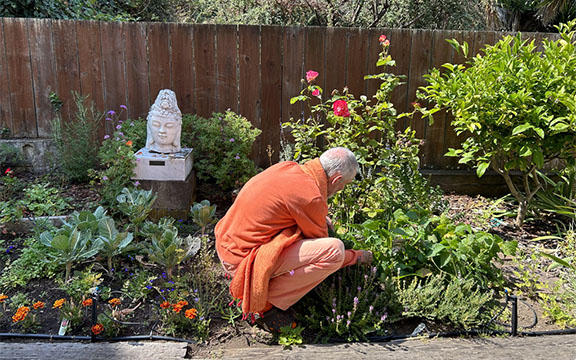
Photo: Swami Ramananda tends to the weeds in the San Francisco IYI garden.
If you want to see well through a window, you have to clean both sides. Practice (abhyasa) and non-attachment (vairagya) work much the same way. They are the complimentary practices given in Patanjali’s Yoga Sutras as a means to quiet the movement of thought in the mind so that we can experience our true nature — a source of unchanging peace within.
In order to see clearly, we must remove anything that would cloud or color our vision. Practice implies a steady effort to calm any thoughts, emotions or prejudices that might prevent clear, neutral perception. For example, if you shake a snow globe with imitation snowflakes inside, and then hold it still, the snowflakes will gradually settle, leaving an unobstructed view. We may think primarily of sitting meditation as a means to still the mind, but practice can include anything done with meditative focus or mindfulness, creating a steady flow of attention.
But only learning to calm the disturbances in the mind does not insure our vision stays clear since we are so often disturbed by the difficulties that we encounter in daily life. Non-attachment works perfectly as a compliment to practice by preventing disturbances from arising. While practice may be pursued by pausing from activity to meditate or quietly focus the mind, non-attachment is meant to help us relate in healthy ways to all the activity in which we engage.
Non-attachment guides us to learn that we cannot depend on anything outside of ourselves for our peace of mind. Non-attachment toward our goals means not depending on the results for that peace. We work with less tension and more clarity when we are not anxious about the outcome. Non-attachment toward the things we enjoy simply means that we can remain at peace even when those things are not available to us. In relationships, we can love more freely if we are not afraid of losing someone’s love or approval.
These two approaches to creating and maintaining a clear and focused mind support each other perfectly. Any effort to develop non-attachment becomes much easier if we begin to experience a natural sense of internal contentment as a result of a regular practice. Feeling this innate peace within, we more readily let go of desires and expectations as the source of our happiness. And if we learn to let go of attachment to the results of our meditative practices, we can pursue them steadily without becoming discouraged or disappointed.
We can develop our practice by meditating regularly with sincere effort and by performing any action with one-pointed attention. Non-attachment can be a little trickier to cultivate. If we look deeply into any situation that causes us to suffer, we can usually find that we are wanting something so much (recognition, admiration, or some experience that we enjoy) that we become disturbed by not getting it. We unintentionally make our peace of mind dependent on acquiring or achieving something.
It can be difficult to observe and analyze our struggles with the clarity and neutrality to see the underlying motives that give rise to suffering. Here again, practice compliments the effort to free ourselves from attachment by calming and strengthening the mind sufficiently to look deeply and objectively at our desires. When we are able to see clearly what we are holding onto in an unhealthy way, we then have the choice to let go.
These two elements of spiritual life empower us to free ourselves from the illusion that we can gain happiness by arranging the people and events around us make our lives happy. It is ultimately our choice. We can all gradually build the mental strength to focus our minds in selfless ways that align our behavior with the Cosmic Will and reveal the natural peace that has always been there.
About the Author:
 Swami Ramananda is the Executive Director of Integral Yoga Institute in San Francisco, a certified Yoga therapist, and a founding board member of the Yoga Alliance. He leads beginner, intermediate and advanced-level Yoga teacher training programs in San Francisco and teaches throughout the world. Having dedicated his life to teaching Yoga for nearly 50 years, Swami Ramananda is highly-respected senior teacher in the Integral Yoga tradition in Yoga communities worldwide. Swami Ramananda co-developed the Stress Management Teacher Training program with Swami Vidyananda, has trained many teachers to bring Yoga into corporate, hospital and medical settings, and has taught mind/body wellness programs throughout the US and abroad. He is also a co-founder of The Spiritual Action Initiative (SAI) which brings together individuals committed to working for social justice for all beings and for the care and healing of our natural world.
Swami Ramananda is the Executive Director of Integral Yoga Institute in San Francisco, a certified Yoga therapist, and a founding board member of the Yoga Alliance. He leads beginner, intermediate and advanced-level Yoga teacher training programs in San Francisco and teaches throughout the world. Having dedicated his life to teaching Yoga for nearly 50 years, Swami Ramananda is highly-respected senior teacher in the Integral Yoga tradition in Yoga communities worldwide. Swami Ramananda co-developed the Stress Management Teacher Training program with Swami Vidyananda, has trained many teachers to bring Yoga into corporate, hospital and medical settings, and has taught mind/body wellness programs throughout the US and abroad. He is also a co-founder of The Spiritual Action Initiative (SAI) which brings together individuals committed to working for social justice for all beings and for the care and healing of our natural world.

